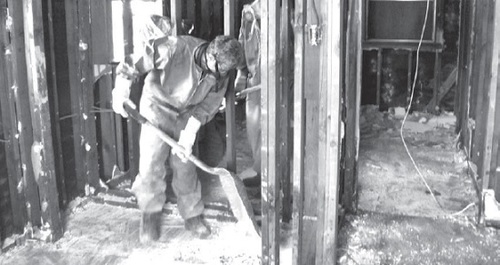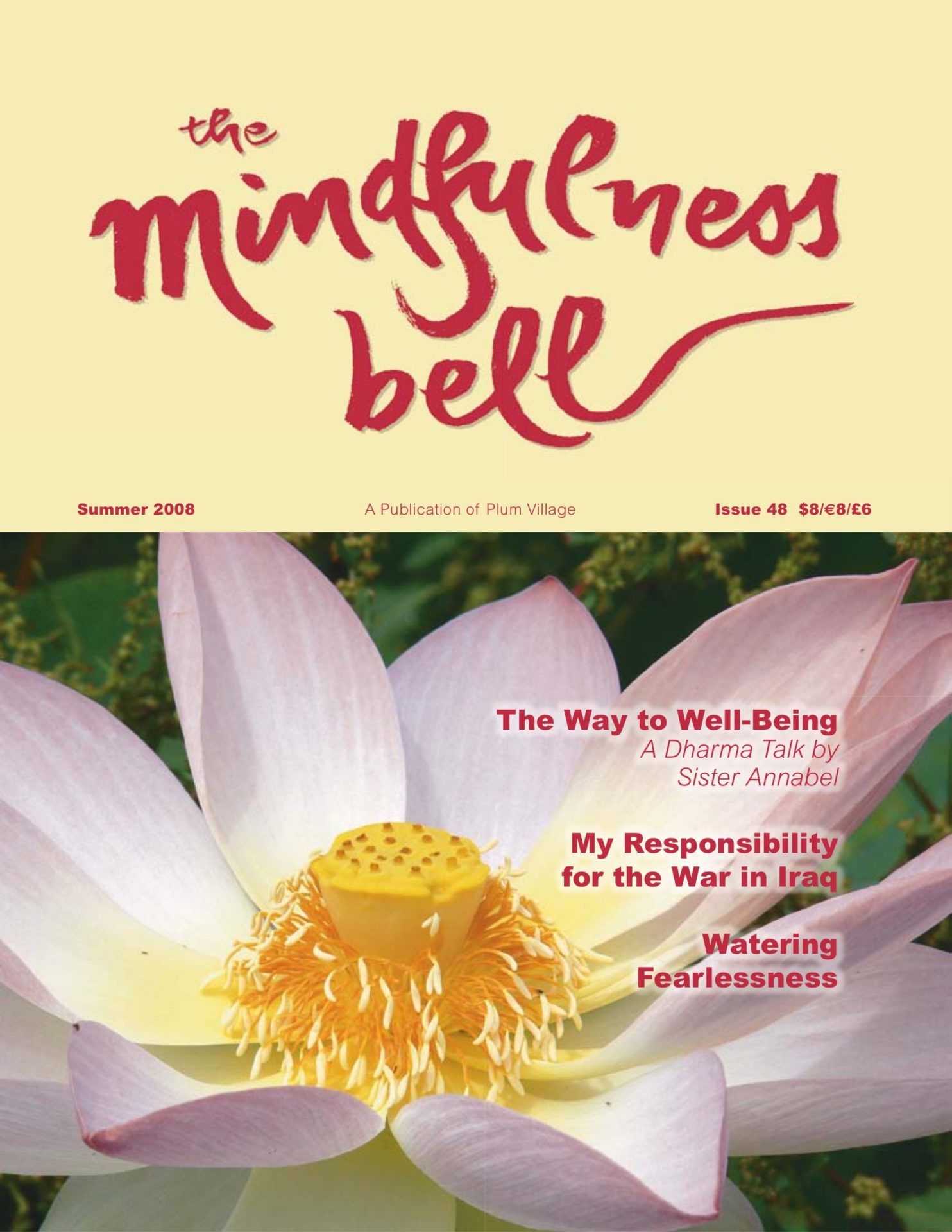By Roberta Schnorr

Sweat.
I am bathed in sweat.
The temperature has gone up ten degrees since breakfast. I have put on more clothes: a long sleeved “Haz-Mat” suit, huge rubber overshoe boots, and three pairs of gloves (nitrile medical gloves, covered by dishwashing gloves, covered by leather work gloves). A respirator conceals my nose and mouth; goggles cover my eyeglasses. Each breath smells and tastes like old rubber tires.
By Roberta Schnorr

Sweat.
I am bathed in sweat.
The temperature has gone up ten degrees since breakfast. I have put on more clothes: a long sleeved “Haz-Mat” suit, huge rubber overshoe boots, and three pairs of gloves (nitrile medical gloves, covered by dishwashing gloves, covered by leather work gloves). A respirator conceals my nose and mouth; goggles cover my eyeglasses. Each breath smells and tastes like old rubber tires. The stale moisture from my lungs accumulates. My glasses fog. Time to move.
To manage these giant boots I learn to pick up each foot a little higher. I take smaller steps; I am conscious of each step. The crotch of my jumpsuit goes to my knees. The legs are long, the body loose and baggy. Sitting, kneeling — and especially getting back up — requires mental planning. Climbing a stepladder in floppy boots and a baggy suit is a new exercise. Once, I almost fall, trying to descend too quickly. I catch myself, regroup, and take it one step at a time. I make certain both feet are on the floor before I pivot or walk away.
My tools are a hammer and a short pry bar. I find that I am able to wrap my thickly gloved fingers around these, and possibly, use them. Time to work.
I am in New Orleans in July. It has been nearly two years since Katrina washed away those old, tired levees. It is not Cajun food or jazz that beckons, but a wish to help drain the stagnant pool left by disaster and neglect. Here I stand, inside my Haz-Mat suit, boots, goggles and triple gloves. I am like the Wicked Witch from The Wizard of Oz.
I Am Melting!
But somehow, I am okay. It seems my fears about my ability to tolerate the heat were unfounded. I am not nauseous. I have no headache, no migraine aura. I am really okay.
I am working with a team of eight people — adults and teenage youth. We are “gutting” a house. Our instructions are simple: all paneling, sheetrock, tile, molding, doors, insulation, carpet, and linoleum must go. We must find and pull every interior nail. All that will remain are two-by-four studs and subfloor.
Three of us begin in a small bedroom. We learn how to negotiate this job and coordinate our movements in the confined space. We work without talking, silenced by bulky respirators.
Everywhere I turn, I notice the water stains on the walls — about twenty-four inches above the floor. This marks the peak — where the floodwaters crested and stood after filling this home. As I pull Sheetrock from interior closet walls I find a barrette and a Barbie doll shoe. I think of my daughters and the bedroom they shared when they were small. This barren space was once a little girl’s room. I picture her, playing with her dolls, trying to sit still while her mother does her hair; sleeping snugly in her “big girl” bed.
It is hot. We take a break every hour. When one of us stops to rest, we tell all the others. We lay down our tools, remove our respirators and gloves, and gather in the backyard. We pull cold water bottles from the cooler and pass them around. We settle under a little shade — on coolers and storage boxes. As we sit and drink the best water we have ever tasted, we notice each other, and more. Sometimes there is a gentle breeze. We are grateful.
Among our little group are friends, and also, new acquaintances. Here we sit, bound by shared effort on this modest, water-stained house. As we huddle in the meager shade, I am struck by what I experience with my new teammates. There is no need to fill the space with chatter. We talk. We listen. We are still. Words or silence — it feels just right.
Working Meditation
I notice, even on my first day, that I find a rhythm and unfamiliar satisfaction as I plug along. The old walls give up Sheetrock easily — except for the six to eight inches near the floor. Real wood baseboard — four inches high — is snugly fastened around each room’s perimeter. I try prying the baseboard from the studs. It does not budge. I kneel down for a closer look. At the bottom of the baseboard is quarter round. A closer look reveals more— carpet strip — a flat strip of wood that fastened the edges of wall-to-wall carpet.
After some experimentation, I figure out how to get under one end of the carpet strip. I use the straight end of my pry bar and hammer, removing the strip three or four inches at a time. I return to my starting place and position my pry bar (the curved end this time) on top of the quarter round, near the baseboard. I hammer down on the curve of the bar and the quarter round gives. Working in tenor twelve-inch sections seems best. Finally, I approach the solid wood baseboard. I move steadily from one two-by-four stud to the next, inserting the curved end of my pry bar, hammering (down) then prying (up), hammering and prying. At some unpredictable point the length of baseboard gives. Long sections come loose.
I realize how different this feels from my usual mind states. I am focused, fully present — not daydreaming or racing to reach some imaginary goal. Occasionally, my mind wanders. I think about an unfinished project that awaits me at home. Each time, I catch my thoughts, let go, come back. I will give it my full attention when I get home. I realize that, perhaps for the first time in my life, I am fully engaged with the task at hand. It seems I am able to be just here, hammering, prying and sliding along. I am not fighting the repetitive work and slow progress — I am pulled into a friendly, rhythmic pace. I work with, not against this old house, coaxing her along, as she slowly surrenders her handsome wood trim.
One day, as we pull Sheetrock from the ceiling, we discover what seems like miles of corner bead, a strong metal trim that forms and sustains the corner joints. Working overhead on a shaky stepladder, it presents a new challenge. I change my method, pulling down all of the Sheetrock first. Blown-in insulation spills out, covering my head and shoulders. I press forward, exposing the
relentless corner bead. I try force. I try pulling. Finally, I concede to its strength and seek its pattern. The corner bead is nailed every three inches. I can free only three inches at a time. I accept this truth and focus on one nail, then another nail.
Something shifts in this moment. The struggle is over. I use my claw hammer — insert at the point of the nail and push away. One by one, the nails come free, often with a single push. As with the baseboard, I find my rhythm, and I am right there, nail after nail, foot after foot of corner bead — like me — just letting go.
An Unexpected Retreat
In New Orleans, in the house of a woman I will never meet, I discovered long, silent hours to be with myself, working mindfully, staying present. I was surprised that in this place, my mind did little wandering, but tuned in, moment by moment, to the present. Here, I did not think about tasks or outcomes, discovering satisfaction as I became one with the process — accessing an unfamiliar rhythm as I pulled sheetrock and molding, freed corner bead, shoveled debris, or pushed a wheelbarrow.
Time with people I hardly knew was pleasant, tranquil. We came together every hour, for cool water and rest. At midday, we traded items from simple box lunches. We talked. We listened. We sat in silence with our weary breath.
In this time far from home, doing unfamiliar work, I was, for many moments, present — to myself, to others. Present — to my experience — right here, right now — in someone’s stripped house in New Orleans.

Roberta Schnorr lives in Central Square, New York with her husband Dick and teenage daughters Grete and Molly. She is an education professor at SUNY Oswego. In July, 2007, Roberta and Grete traveled to New Orleans with members of a Lutheran church to assist families whose homes were damaged by Hurricane Katrina.

